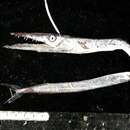Diagnostic Description
provided by Fishbase
Dark brownish, silvery ventrally; paired fins and caudal fin uniformly black. Body extremely elongate. Large adults with a pair of dermal keels midlaterally on each side. Small, flexible projection at tip of lower jaw. Gill membranes joined forward, below anterior edge of eye, and free from isthmus. No rayed dorsal fin. No scales (Ref. 43939). In adults, head depth 29-33% of lower jaw length. Postorbital area 8.1-9.7% SL or 34.4-38.8% (less than 3 times smaller than HL). Rear edge of gill cover overlaps with the vertical of the 5th vertebrae. Postadipose distance 7-8% SL (Ref. 31260).
Morphology
provided by Fishbase
Dorsal spines (total): 0; Dorsal soft rays (total): 0; Analspines: 0; Analsoft rays: 14 - 17; Vertebrae: 78 - 80
Trophic Strategy
provided by Fishbase
Found in a wide range of depths, sometimes near surface (Ref. 2850) to below 2,000 m. Larger adults inhabit colder water toward the poles, whereas, the young and smaller adults inhabit more temperate regions (Ref. 35956). Feed on mollusks, crustaceans, marine worms, coelenterates, salps, and fishes (Ref. 4525, 6885). Its distensible body wall and large stomach can accommodate prey up to half of its own length. Preyed upon by albacore, Pacific lancetfish, halibut, steelhead salmon, blue shark, pomfret, and whales (Ref. 6885).
- Recorder
- Grace Tolentino Pablico
Biology
provided by Fishbase
Found in a wide range of depths, sometimes near surface (Ref. 2850) to below 2,000 m. Larger adults inhabit colder water toward the poles, whereas, the young and smaller adults inhabit more temperate regions (Ref. 35956). Feed on mollusks, crustaceans, marine worms, coelenterates, salps, and fishes (Ref. 4525, 6885). Its distensible body wall and large stomach can accommodate prey up to half of its own length. Oviparous, with planktonic larvae (Ref. 35956). Preyed upon by albacore, Pacific lancetfish, halibut, steelhead salmon, blue shark, pomfret, and whales (Ref. 6885).
- Recorder
- Estelita Emily Capuli
Anotopterus nikparini: Brief Summary
provided by wikipedia EN
Anotopterus nikparini is a species of fish in the family Anotopteridae, the daggertooths. It is native to the northern Pacific Ocean, where it occurs as far north as the Bering Sea and as far south as Japan and Baja California.
This fish can be found near the surface to depths below 2000 meters. Populations in colder regions are mainly larger, older adults.
This species feeds on molluscs, crustaceans, marine worms, salps, and fish. It is an important predator of Pacific salmon. In turn, it is a prey item for whales and large fish such as albacore, lancetfish, halibut, steelhead, pomfret, and blue shark.
- license
- cc-by-sa-3.0
- copyright
- Wikipedia authors and editors

